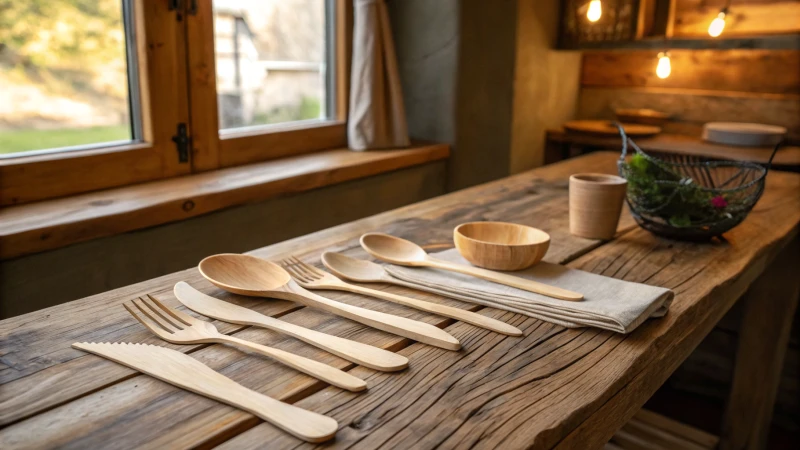
Ever wondered if switching to wooden cutlery is as safe as it is green?
Disposable wooden cutlery is generally a safe and eco-friendly alternative to plastic, though it can harbor bacteria if mishandled. To ensure safety, store properly, minimize contact with food for extended periods, and select high-quality certified products.
Switching to wooden cutlery often feels like a no-brainer for those of us keen on sustainability. But just like the first time I tried convincing my friends to ditch plastic straws, there are always questions about safety. The good news is that wooden utensils are inherently safer for the environment, breaking down naturally without leaving a trace.
However, it’s essential to be mindful of their handling to avoid bacterial contamination—something I learned the hard way during a particularly humid picnic. Proper storage and selecting top-tier certified products are crucial to ensuring that our eco-friendly habits are as hygienic as they are green. Let's explore how we can make this transition smoother and safer.
Wooden cutlery is more eco-friendly than plastic.True
Wooden cutlery is biodegradable, reducing environmental impact compared to plastic.
Wooden cutlery poses no risk of bacterial contamination.False
Improper handling or storage can lead to bacterial contamination of wooden cutlery.
How Does Wooden Cutlery Compare to Plastic in Terms of Environmental Impact?
I remember the first time I held a wooden spoon at a local café, wondering if it truly made a difference for our planet.
Wooden cutlery is generally more environmentally friendly than plastic, as it is biodegradable, compostable, and often made from renewable resources. In contrast, plastic cutlery is derived from non-renewable fossil fuels and can take hundreds of years to decompose.
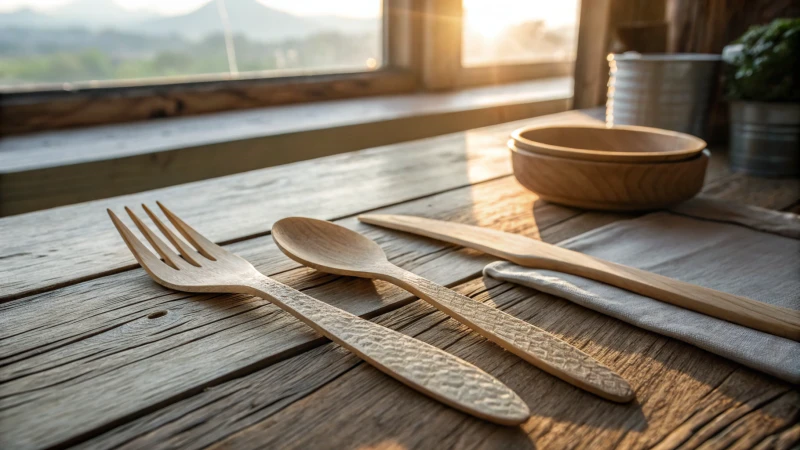
Biodegradability and Compostability
I’ve always been fascinated by how things break down over time. Imagine this: after a big picnic in the park, you toss your wooden fork into the compost bin, and just like that, nature takes over. Wooden cutlery, typically made from birch or bamboo, is a champion of biodegradability, gracefully breaking down within a few months. It's like nature's magic trick—one minute it's there, and then it’s gone, nourishing the earth. On the flip side, plastic cutlery1 seems to hang around like an uninvited guest, overstaying its welcome for hundreds of years in landfills.
Carbon Footprint
I recall a conversation with a friend who works in sustainability about how much energy goes into making everyday items. Wooden cutlery generally boasts a lower carbon footprint because its production isn't as energy-intensive as plastic. When you think about it, plastic production2 requires extracting and refining fossil fuels—it's like waking up an old dinosaur just to make a fork. All these processes contribute significantly to greenhouse gas emissions.
Resource Utilization
The beauty of wooden cutlery lies in its renewable nature. Each piece is crafted from resources that can be replenished over time, aligning perfectly with sustainable forestry practices. In contrast, plastic cutlery relies heavily on finite fossil fuel reserves. Here's a table comparing resource utilization:
| Aspect | Wooden Cutlery | Plastic Cutlery |
|---|---|---|
| Resource Type | Renewable | Non-renewable |
| Resource Depletion | Low | High |
| Sustainability | High | Low |
Health and Hygiene
A friend once voiced concerns about wooden cutlery potentially harboring bacteria. Indeed, if left untreated, wood can be porous and might hold onto unwanted guests—like bacteria. Plastic cutlery, while less eco-friendly, offers a more sterile option due to its non-porous nature. But don't fret! Advancements are underway with treatments and coatings enhancing wooden cutlery's safety and durability.
Wooden cutlery is biodegradable within months.True
Wooden cutlery breaks down naturally in a few months under proper conditions.
Plastic cutlery has a lower carbon footprint than wood.False
Plastic production is energy-intensive, involving fossil fuel extraction and refining.
What are the main hygiene concerns with wooden cutlery?
Ever thought about the hygiene behind your wooden cutlery while relishing a meal?
Wooden cutlery can harbor bacteria due to its porous surface and moisture retention. However, by ensuring thorough drying and occasionally treating them with food-safe oils, these risks can be significantly reduced.
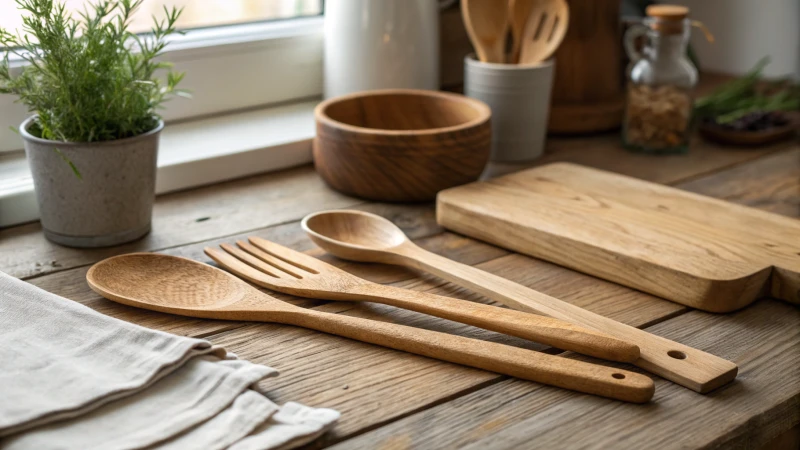
The Porous Nature of Wood
I remember the first time I decided to switch to wooden cutlery3. It was at a charming little café where everything was eco-friendly and wonderfully rustic. But then, a friend pointed out that wood, being porous, might trap bacteria. It's true—wood's natural texture allows it to absorb moisture, which can create a cozy environment for bacteria if not properly cared for. So, after washing my wooden utensils, I always make sure they’re thoroughly dried. Regular maintenance is key!
Impact of Moisture Retention
It's like dealing with a sponge; leave it wet and unwanted things start growing. Wood’s ability to retain moisture can lead to mold and bacteria. I’ve found that using a food-safe oil treatment4 once in a while creates a protective barrier, adding an extra layer of safety.
| Potential Hygiene Issues | Solutions |
|---|---|
| Bacterial growth | Regular drying |
| Mold formation | Oil treatment |
| Contamination risk | Proper storage |
Cleaning Practices
Cleaning wooden cutlery is a bit like caring for a treasured heirloom—gentle and mindful. Avoid soaking them in water, as tempting as it might be after a heavy meal. Instead, quickly wash and dry thoroughly. Some eco-friendly detergents5 have become my go-to for sanitizing without harming the wood.
Handling and Storage
I’ve learned that how you store wooden cutlery matters just as much as how you clean it. They need space to breathe, so I keep them in a dry, airy spot, avoiding cramped drawers where moisture might sneak in. Using a storage rack6 with good air circulation is ideal for keeping them fresh and ready for the next meal.
Wooden cutlery can harbor bacteria if not dried properly.True
The porous nature of wood allows moisture retention, promoting bacterial growth.
Soaking wooden cutlery in water helps prevent mold.False
Soaking increases moisture absorption, which can lead to mold growth.
How Can You Ensure the Safe Use of Wooden Cutlery?
Ever had that moment of doubt when choosing wooden cutlery for its eco-friendliness, wondering if it’s truly safe?
To safely use wooden cutlery, clean it with mild soap and water, avoid leaving it wet, and store it dry. Regularly check for cracks or splinters to ensure hygiene and effectiveness.
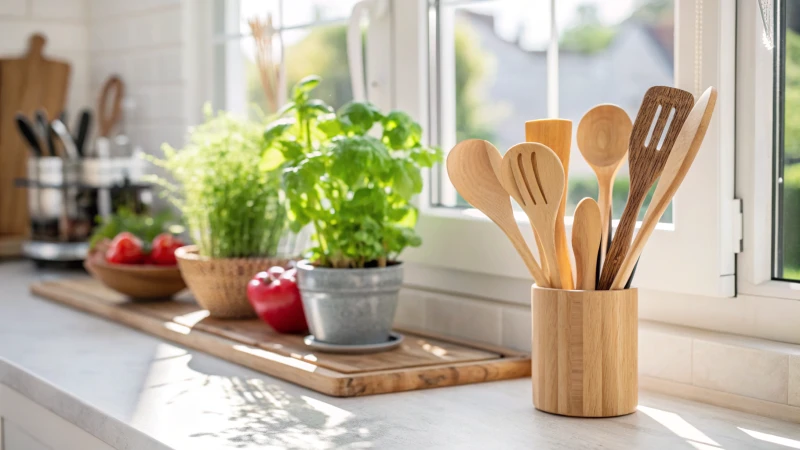
Cleaning and Maintenance
I remember the first time I switched to wooden cutlery; I was thrilled by the eco-friendly aspect but nervous about maintaining it. The key is proper cleaning: wash by hand using mild soap and warm water right after meals. One day, I left a spoon soaking overnight—a rookie mistake that taught me never to let them sit in water too long, as it led to warping. Now, I make sure to dry them thoroughly with a cloth and store them in a dry spot.
Inspecting for Damage
Over time, I learned the importance of regular inspections. Once, I noticed a tiny crack in my favorite wooden fork, which could have harbored bacteria. After that incident, I routinely check for any splinters or damage to prevent any hygiene issues or accidents. If anything looks off, I replace it immediately.
Oiling for Longevity
A friend shared a tip about oiling wooden utensils to keep them in top shape. Applying food-safe mineral oil prevents drying and cracking. I now enjoy the simple ritual of rubbing a small amount onto the cutlery with a soft cloth and letting it soak overnight.
Comparing Wooden Cutlery Safety
| Feature | Wooden Cutlery | Metal Cutlery | Plastic Cutlery |
|---|---|---|---|
| Eco-friendliness | High | Moderate | Low |
| Durability | Moderate (prone to cracks/splinters) | High (resistant to wear) | Moderate (can warp with heat) |
| Maintenance | Requires regular oiling and inspection | Requires simple cleaning | Easy, often disposable |
| Safety | Safe if well-maintained | Generally safe | May leach chemicals if not BPA-free |
Embracing Sustainable Practices
In embracing sustainable practices, I've found that wooden cutlery aligns beautifully with my values—especially when sourced from responsibly managed forests. By looking for FSC-certified products, I can confidently choose options that support environmental conservation. Understanding the benefits and maintenance7 has made my transition smoother and more rewarding, knowing that I'm contributing to a greener planet.
Wooden cutlery should be soaked in water for cleaning.False
Soaking wooden cutlery can cause warping or splitting.
Applying mineral oil extends the life of wooden utensils.True
Oiling prevents drying and cracking, enhancing longevity.
Are There Certifications for Safe and Sustainable Wooden Cutlery?
Have you ever wondered if your wooden cutlery is both safe and sustainable?
Yes, wooden cutlery can be certified for safety and sustainability through certifications like FSC and PEFC for responsibly sourced wood, and FDA and EU standards for food safety.
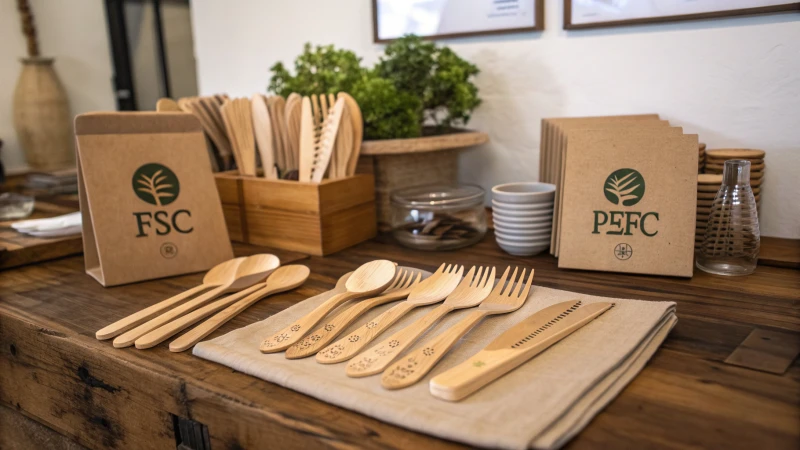
Understanding Wooden Cutlery Certifications
I remember the first time I came across wooden cutlery at a picnic. It was love at first sight—not only did they look eco-friendly, but they also felt like a step in the right direction for our planet. However, I quickly learned that not all wooden cutlery is created equal. Certifications such as the Forest Stewardship Council (FSC8) and the Programme for the Endorsement of Forest Certification (PEFC9) are crucial. They assure us that the wood comes from responsibly managed forests, making it easier to enjoy our meals guilt-free.
Food Safety Standards
Of course, there's more to consider than just where the wood is sourced. When I started using wooden cutlery at home, I wanted to make sure they were safe for my family. That's where food safety standards come in. The Food and Drug Administration (FDA10) in the U.S. and the European Union's EC 1935/2004 standard ensure that materials used in food contact are safe and don't release harmful substances into our meals.
Evaluating Eco-Friendliness
In my journey towards sustainability, I discovered certifications like Cradle to Cradle Certified™ (C2C11), which evaluate a product’s lifecycle impact. They consider everything from material health to renewable energy use. Knowing a product has passed these evaluations reassures me that I'm making a responsible choice.
| Certification | Purpose |
|---|---|
| FSC12 | Ensures wood is sourced sustainably |
| PEFC13 | Promotes sustainable forest management |
| FDA14 | Regulates food safety standards |
| EC 1935/2004 | Ensures materials are safe for food contact |
| C2C15 | Evaluates lifecycle sustainability |
Industry Examples and Insights
I think of companies like WonBon, which source their wooden cutlery from FSC-certified forests while adhering to FDA regulations. This approach not only appeals to eco-conscious consumers but also ensures that businesses like mine can confidently offer safe and sustainable options.
For professionals like Michael16 in government procurement or Emily17 in luxury branding, these certifications are invaluable. They allow us to integrate eco-friendly products into our operations seamlessly.
Understanding these certifications helps me make informed choices that support both environmental sustainability and consumer health. Whether it's for a restaurant chain or an e-commerce platform, aligning with certified suppliers means meeting necessary safety and sustainability standards.
In conclusion, exploring these certifications is a game-changer. It impacts purchasing decisions and contributes significantly to broader sustainability goals across various sectors like hospitality, healthcare, and retail. Staying informed about these standards is crucial to ensuring products meet the necessary eco-friendly and safety requirements.
FSC certification ensures sustainable wood sourcing.True
FSC certifies that wood is sourced from responsibly managed forests.
FDA regulates eco-friendliness of wooden cutlery.False
FDA focuses on food safety, not the environmental impact of products.
Conclusion
Disposable wooden cutlery is eco-friendly and biodegradable but can harbor bacteria if mishandled. Proper storage, cleaning, and selecting certified products enhance safety while supporting sustainability.
-
Learn about the long-lasting effects of plastic waste on ecosystems and how it contributes to pollution. ↩
-
Discover how the extraction and refining processes for plastics increase greenhouse gas emissions. ↩
-
Understanding wood's porosity helps manage hygiene by informing cleaning and drying practices. ↩
-
Learn about food-safe oils that prevent moisture absorption and enhance the durability of wooden utensils. ↩
-
Discover cleaning products that maintain the integrity of wooden cutlery while ensuring hygiene. ↩
-
Explore methods to store wooden cutlery that prevent moisture buildup and contamination. ↩
-
Learn effective cleaning methods to ensure wooden cutlery remains hygienic and safe for everyday use. ↩
-
Learn how FSC certification guarantees sustainable wood sourcing. ↩
-
Explore how PEFC promotes sustainable forest management. ↩
-
Discover FDA's role in ensuring food safety. ↩
-
Understand how C2C evaluates product sustainability. ↩
-
Learn how FSC certification guarantees sustainable wood sourcing. ↩
-
Explore how PEFC promotes sustainable forest management. ↩
-
Discover FDA's role in ensuring food safety. ↩
-
Understand how C2C evaluates product sustainability. ↩
-
See how Michael integrates eco-friendly products. ↩
-
Learn how Emily uses eco-friendly branding strategies. ↩

